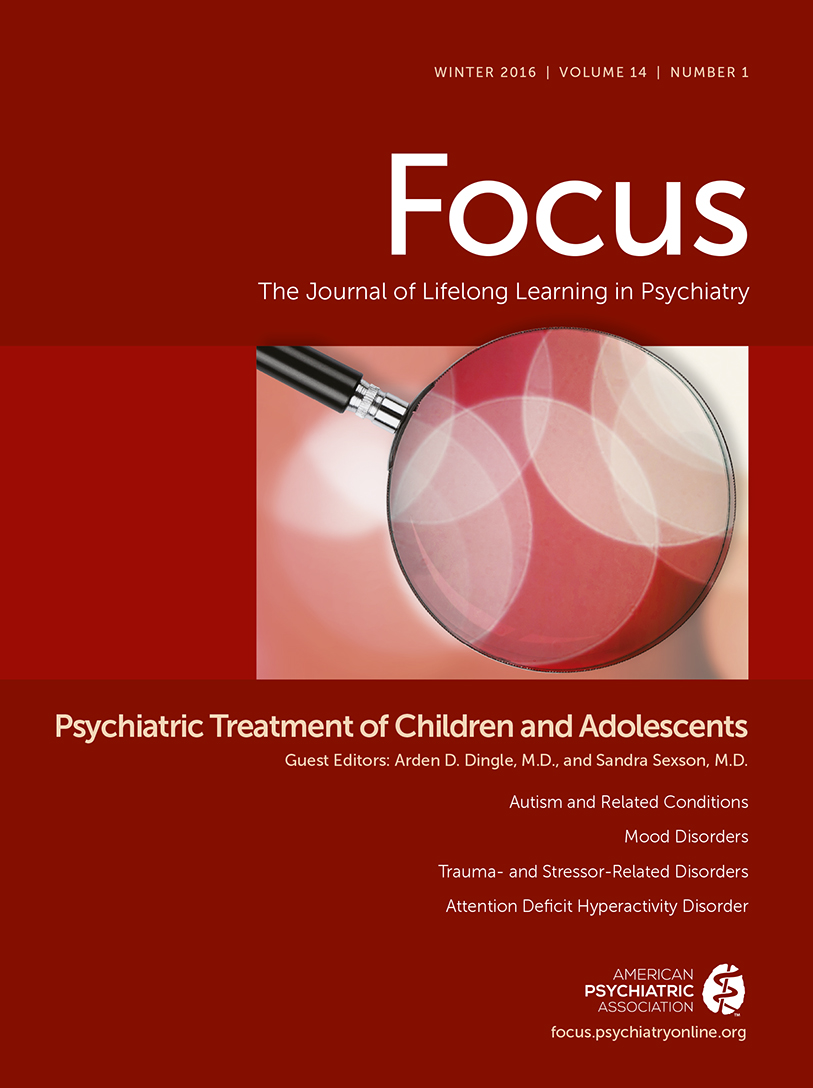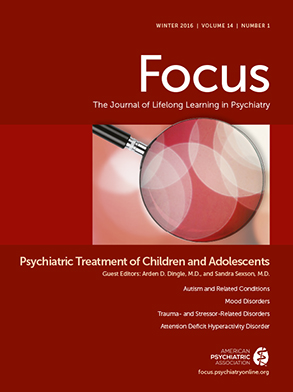Attention-Deficit Hyperactivity Disorder Across the Lifespan
Abstract
BOX 1. DSM-5 Criteria for Attention-Deficit Hyperactivity Disordera
Epidemiology
Comorbidity
Etiology and Risk Factors
Pathophysiology
Cognitive Deficits
Neuroanatomical Findings
Functional Neuroimaging
Course and Prognosis
Clinical Evaluation
Interview
| Topic | Preschool | School Age | Adolescent | Adult |
|---|---|---|---|---|
| Symptom presentation | Hyperactivity and impulsivity predominate, difficulty attending to story time, refusal to nap, climbing on furniture, will not hold hand in store | Combined presentation of ADHD most common; failure to attend to and complete school work leads to referral; shows classic DSM-5 symptoms | Inattentive presentation becomes more common, hyperactivity presents as internal restlessness, impulsivity as poor choices; milder cases may present for first time, but symptoms should have started in childhood | Failure to enter or complete college despite intelligence, job terminations; moving from job to job; disorganization and poor time management |
| Interview with patient | Observation of child, only, take note of developmental milestones particularly language | Interview patient alone to explore mood/anxiety issues, only a minority of children will acknowledge ADHD symptoms; sitting still in interview does not rule out ADHD | Separate interviews of parent and child preferred; ask adolescent about illicit drug/alcohol use, relationship issues; adolescent more aware of symptoms but may minimize impact | Adult is primary source of history; review 18 ADHD symptoms with focus on job and social functioning; adult ADHD rating scales are highly useful to prompt interview; must establish childhood onset of impairment |
| Collateral information | Obtain reports from preschool or daycare | Rating scales from teacher, school conduct folder | More difficult to get rating scales from middle/high school teachers; report cards can be useful substitutes | Spouse or parents can provided useful collateral; negative work evaluations may show evidence of ADHD symptoms |
| Common comorbidities | Language delays, ask about social skills, screen for autism spectrum disorders | Oppositional defiant disorder, anxiety disorders | Oppositional defiant disorder, anxiety, depression, substance use disorders | Anxiety, depression, mania, or early-onset dementia in 40- to 50-year-old group; substance use and diversion |
| Health issues | If developmental delays present, review medical history for any congenital conditions | Medical history negative in most cases, pediatric referral for specific medical conditions only | Obesity, accidental injury, sexually transmitted diseases | Hypertension, thyroid issues, and diabetes become more common; counsel patient to see primary care physician regularly |
| Treatment issues | Stimulant response rate somewhat lower than in other age groups | Stimulant response rate up to 90% | Stimulant response rate up to 90%; beware of diversion of stimulant | Stimulant response rate up to 90%; be aware of drug interactions with other agents |
Psychological Testing
Medical Evaluation and Laboratory Tests
Pharmacotherapy
Stimulants
| Medication and Dosing | Preschool Age Range (<25 kg) | Later School Age and Younger Adolescents (25–40 kg) | Older Adolescents and Adults (>40 kg) |
|---|---|---|---|
| Stimulants | |||
| Methylphenidate (t.i.d.) | 2.5–10 | 15–20 | 25–30 |
| Methylphenidate OROS (every morning) | 18–36 | 54–72 | 90–108 |
| Dexmethylphenidate (b.i.d.) | 1.25–5 | 7.5–10 | 12.5–15 |
| Controlled-release dexmethylphenidate (every morning) | 5–10 | 15–20 | 30 |
| Amphetamine (b.i.d.) | 1.25–5 | 7.5–10 | 12.5–30 |
| Controlled-release amphetamine | 5–10 | 15–20 | 25–60 |
| Lisdexamfetamine (every morning) | 20–30 | 40–50 | 60–70 |
| Nonstimulants | |||
| Clonidine | 0.05–0.1 h.s. | 0.1 b.i.d. to 0.1 t.i.d. | 0.1 q.i.d. |
| Extended-release clonidine | 0.1 h.s. | 0.1 b.i.d. to 0.1 every morning/0.02 h.s. | 0.2 b.i.d. |
| Guanfacine | 0.5 h.s. to 0.5 b.i.d. | 1 b.i.d. to 1 every morning/2 h.s. | 2 b.i.d. or 1 q.i.d. |
| Extended-release guanfacine | 1 every morning | 2–3 every morning | 4 every morning |
| Atomoxetine | 10–20 every morning/10 every night | 18–25 b.i.d. | 40 b.i.d. |
Atomoxetine
Alpha-Agonists
Psychosocial Interventions
Conclusions
References
Information & Authors
Information
Published In
History
Authors
Funding Information
Metrics & Citations
Metrics
Citations
Export Citations
If you have the appropriate software installed, you can download article citation data to the citation manager of your choice. Simply select your manager software from the list below and click Download.
For more information or tips please see 'Downloading to a citation manager' in the Help menu.
View Options
View options
PDF/EPUB
View PDF/EPUBLogin options
Already a subscriber? Access your subscription through your login credentials or your institution for full access to this article.
Personal login Institutional Login Open Athens loginNot a subscriber?
PsychiatryOnline subscription options offer access to the DSM-5-TR® library, books, journals, CME, and patient resources. This all-in-one virtual library provides psychiatrists and mental health professionals with key resources for diagnosis, treatment, research, and professional development.
Need more help? PsychiatryOnline Customer Service may be reached by emailing [email protected] or by calling 800-368-5777 (in the U.S.) or 703-907-7322 (outside the U.S.).

